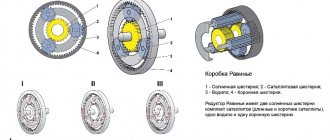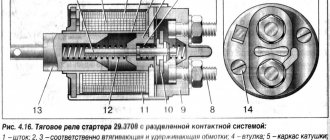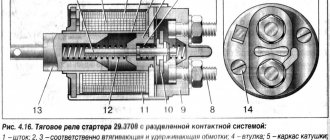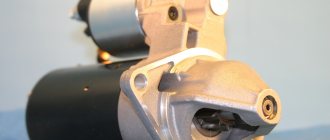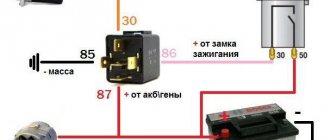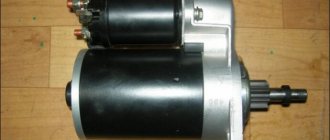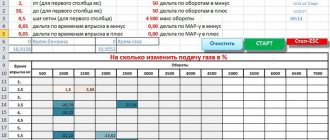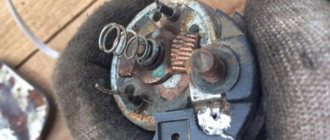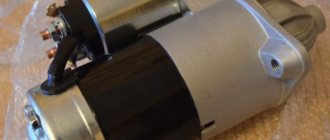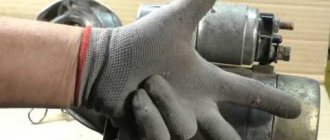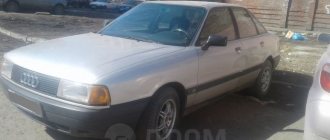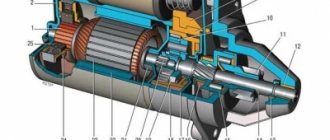Starter with planetary gear
A starter is a device in the car's starting system that spins the engine crankshaft to the speed required for starting.
Work in the field of improving electric motors has made it possible to create a simple and fairly lightweight design of a starter with excitation by permanent magnets and with reduction gear.
The figure shows the armature and reduction gear of the Bosch DW starter. The reduction gear is a planetary gear set, the sun (central) gear of which is fixed to the armature shaft, and the output power is removed from the carrier, on the axes of which freely rotating satellites are installed. The planetary gears with external teeth are made of steel, and the epicyclic gear (with internal teeth) is made of a polyamide compound with mineral additives or powder metallurgy to increase wear resistance.
Rice. Starter electric motor with reduction gear: 1 – planetary gear carrier shaft with oblique splines; 2 – epicycle of planetary gear; 3 – satellites; 4 – sun gear mounted on the shaft; 5 – anchor; 6 – collector
The figure shows a schematic design of the starter.
Rice. Bosch DW starter diagram with permanent magnets and reduction gear: 1 – gear; 2 – flywheel crown; 3 – overrunning clutch; 4 – control lever; 5 – planetary gear; 6 – permanent magnet; 7 – anchor; 8 – collector with graphite brushes; 9 – electromagnetic drive with retracting and holding windings; 10 – starter switch; 11 – battery
The satellites, pressed from powder, rotate on axes in plain bearings or needle bearings. The latter are preferable, as they provide greater gearbox efficiency. The satellite axis is also the inner race of the needle bearing. This places high demands on the material and precision of the axes. The central gear is made integral with the armature shaft or can be removable. To obtain minimal mechanical losses and ensure a high service life, increased demands are placed on the precision of manufacturing gears and other gearbox parts. High-quality lubricants are used for the same purpose. The gear ratio is usually 3…5.
The starter armature with gearbox has design features. The armature winding is impregnated with a compound that reduces the likelihood of it being carried away. Due to the increased rotation speed, the armature must undergo dynamic balancing. To reduce losses due to hysteresis and eddy currents, the armature package is assembled from thin-sheet (0.5 mm thick) electrical steel plates.
Due to the reduced metal consumption and increased power density, starters with gearboxes have higher thermal stress compared to starters without gearboxes.
The most important part in starters with a gearbox is the brush-commutator assembly. The current density under the brushes in maximum power mode is 1.5...2.5 times higher than the current density of conventional starters. In such conditions, the use of special brushes with a high graphite content on the running edge is required. This increases the resistance of the switched circuit and improves switching. In addition, the brushes are shifted against the direction of rotation by 0.3...0.5 commutator divisions. As a result, the wear rate of brushes and commutator is reduced to the level of starters without gearboxes.
The magnets used are permanent magnets made of strontium ferrite, which have an increased coercivity compared to magnets made of barium ferrite. The increased coercive force increases the resistance of the magnets against demagnetization by the armature reaction at the moment the starter is turned on when the short circuit current is applied. To increase resistance to demagnetization, special treatment of the running section of the magnet is used, leading to an additional local increase in the coercive force, and the number of poles is also increased.
This starter is 40% lighter than a conventional starter and is designed for use with engines up to 5 liters in volume.
Source
Starter with gearbox
The parameter that determines the rational coordination of the power characteristics of the electric starting device with the starting characteristics of the internal combustion engine is the gear ratio /df of the drive from the starter to the engine. This parameter affects the angle of inclination of the mechanical characteristics of the starter motor related to the crankshaft of the internal combustion engine. For each engine and given starting conditions, there are optimal gear ratios at which the power characteristics of the starting device are best used. However, with gearless
transmission, the gear ratio /dc can be no more than 16, which is limited by the conditions of the mechanical strength of the starter drive gear.
On the other hand, increasing the gear ratio makes it possible to reduce the size and, accordingly, the weight of the starter motor, since these parameters change in inverse proportion to the shaft speed. In recent years, one of the main directions for improving starting systems has been to reduce the mass of active materials, the cost of which is about 50% of the cost of the starter. At the same time, in addition to using such well-known methods as replacing copper winding wires with lighter aluminum ones and reducing dimensions through the use of insulation of a higher heat resistance class, high-speed, small-sized starter electric motors with a built-in gearbox have become increasingly used.
In Fig. Figure 2.20 shows, as an example, the dependence of the mass of active materials m on the calculated rated rotational speed of the rotor of a 1.4 kW starter motor. The total mass of the starter vehicle depends on its rated power Рс (Fig. 2.21). In this case, the advantages of starters with gearboxes appear starting from a power of approximately 1 kW. For low-power starters installed on carburetor internal combustion engines with a small displacement, the use of a gearbox does not reduce the total weight of the vehicle. For them, it is advisable to use direct drive.
Which starter is better, gearbox or conventional? Choose the appropriate conclusion for yourself »
You can often hear the question of which starter is better: a gearbox or a conventional one. Most often, this question is asked by people who own fairly old cars. After all, even before the beginning of 2000, most models were equipped with old-style starters. Nowadays, this type of starting device is practically not found on new models, although they are still found. But, nevertheless, the question is mainly not about new cars, but about those that have traveled across the expanses of our country. Motorists are conservative people, so they are usually very wary of more modern spare parts. From this article you can learn about all the nuances of both types of starters.
Which starter is better, geared or conventional, to answer this question, you need to take a closer look at both types of devices for starting the engine.
In a conventional starter, the force from the armature is transmitted directly to the flywheel. This activates the traction relay, which pushes the overrunning clutch (Bendix) forward, allowing it to engage the flywheel teeth. This type of design allows you to start the engine without any problems. At one time, this type of starter seemed advanced, especially compared to the curve.
The gear starter has a similar structure to the simple version. But, it has a number of differences. The main difference is in the transmission of force. For this, a gearbox is used, which makes it possible to reduce the power of the electric motor. Another important feature of this type of starter is the presence of permanent magnets in the winding, which makes the electric motor more reliable.
In general, a gear starter is more reliable. Its only weak point is the overrunning clutch. There is a gear on it that wears out quite quickly. Therefore, many, having encountered this type of engine starting device once, refuse them in the future. But otherwise they are more reliable. Conventional starters are notorious for problems with brushes and retractors. Because of this, the starter has to be repaired regularly.
You also need to compare the maintainability of both starters. The easiest way to restore the functionality of a simple starter. Its design is as simple as possible. And it does not cause any difficulties even for an inexperienced car enthusiast. The gear starter is somewhat more complicated. To properly assemble its main part (gearbox), considerable skill in repairing such structures is required. What helps in this situation is that all elements (except Bendix) on such starters last 2 times longer.
The energy consumption of a gear starter is much less. This is due to the presence of an additional mechanism that enhances the torque of the electric motor. That is why these starters are significantly smaller compared to conventional ones. Such a starter works quietly even with a slightly seated battery, which a regular starter cannot do. For comparison, let's look at the average powers of two types of starters:
Planetary gearbox: description, advantages, characteristics, operating principle.
A two-stage planetary gearbox is a structure made up of gears and other working elements that are driven by a gear drive. At the same time, they move according to the principle that is inherent in the mechanics of planetary rotation - around one center. For this reason, the central gear is called the “sun” gear, the intermediate ones are called “satellites”, and the outer one with the internal gear clutch is called the “crown”. In addition, the simplest planetary gearbox consists of a carrier. It is designed to fix the satellites relative to each other so that they move together.
For proper operation of the device, it is necessary that one of its constituent parts be rigidly fixed to the body. In a planetary gearbox, which is equipped with a carrier, it is the static part. In addition, the ring gear or sun gear can be rigidly fixed. If none of the parts of this device are fixed, it is possible to split one movement into several, or merge two into one.
In this case, in coupling with the drive and driven shafts there can be both ring and sun gears, or satellites. This mechanism can increase the gear ratio and reduce the torque and vice versa.
This design ensures that the driven and drive shafts move in the same direction.
Types of gear starters.
A gear starter comes with external and internal (planetary) gear teeth.
Geared starter with external gearing.
The gearbox in starters with external gearing is located inside the housing, between the armature shaft and the bendix shaft and consists of two gears. The small gear is made in one piece with the armature shaft or is mounted on its splines. The large one is connected to the bendix shaft. Torque from the armature shaft is transmitted to the small gear of the gearbox, which, when rotated, transmits torque to the bendix shaft.
Advantages of planetary devices
Compared to traditional gearboxes, we can highlight the following advantages that this device has: they can create huge speed ratios with a low number of gears. The gears of the mechanism are small in size due to their number. Thus, one more massive wheel distributes the load evenly across several satellites. It follows from this that the device is not very large and bulky. However, calculations and practice show that at high gear ratios, performance and efficiency are greatly reduced. And as a conclusion of all of the above, the main advantages are:
Such advantages also require appropriate manufacturing. Starting from calculation, design and ending with manufacturing - everything must be precisely accurate. These gearboxes have found a very wide range of applications in various industries: instrument making, machine tool manufacturing, mechanical engineering, etc. In this article we will dwell in more detail on the use of this device in the mechanical engineering industry.
Description and principle of operation:
Planetary gearboxes have a number of common features with spur gearboxes, since force transmission also occurs through a gear drive, and gears are used in the design. However, the design of planetary gearboxes, as well as the operating principle, is more complex.
In general, the following main parts can be distinguished in a planetary gearbox: ring gear, planetary gears (satellites), carrier and sun gear. By analogy with the Sun, located in the center of the solar system, the sun gear is located in the center of the working part of the gearbox. It meshes with identical planetary gears, the axes of which are located on a circle, the center of which lies on the axis of the sun gear, and at the same time the planet gears are engaged with the ring gear, which is an internal gear. The carrier rigidly secures all the satellites relative to each other.
For a planetary gearbox to operate, it is necessary that one of its parts (sun gear, ring gear or carrier) be rigidly attached to the gearbox housing. Depending on the choice of the driving and driven elements, the gear ratio of the planetary gearbox will depend. Also, the operation of a planetary gearbox is possible even when none of its parts are secured. In this case, it becomes possible to decompose one movement into two (for example, from the sun gear to the ring gear and carrier), or to merge two movements into one.
Classification of planetary gearboxes:
Based on the number of stages of the planetary gearbox, the following are distinguished:
Single-stage gearboxes are the most compact, while multi-stage gearboxes are much more complex in design and take up more space, but allow large gear ratios to be achieved.
Based on the fact of rigid fastening of one of the gearbox elements, the following are distinguished:
In the simplest planetary gearboxes, one of the links is rigidly fixed, and force is transmitted from one of the loose links to another with a fixed gear ratio. In differential gearboxes, none of the elements are fixed, which allows the gearbox to be used as a differential mechanism.
DEVICE OF PLANETARY REDUCER
The main parts of a planetary gearbox are usually elements such as the sun gear, which, as mentioned above, is located in the center of the gearbox. The same basic elements include the carrier. This part of the gearbox is designed to firmly fix the axes of the remaining gears, or as they are also called satellites. The satellites are identically sized gears that are located around the main gear. And finally, another important part of the planetary gearbox is the gear, which is called the ring gear. This gear has the appearance of a toothed wheel, which is located along the edge of all parts of the gearbox; this part has a coupling with the satellites. The operating principle of a planetary gearbox is as follows.
One of the elements of this device always remains motionless, in this case it is a ring part. The leading part in a planetary gearbox is the sun gear, and the driven parts are the satellites. As a rule, the most common use of planetary gearboxes is in such industries as mechanical engineering. However, it is often also used in the manufacture of various types of machines for cutting metal. Quite often, several planetary gearboxes are used at once; as a rule, these gearboxes are equipped with an automatic transmission.
Planetary gearboxes in mechanical engineering
Gearboxes that have a device of this type are widely used in drive axles of cars and in automatic gearboxes. Wheel gearboxes can be found in axles of such vehicles as: MAZ, Ikarus, in some trolleybuses, T-150K, K-700 tractors. This wheel reducer in axles transmits torque to the wheel hubs from the axle shafts. They are also common in airborne transmissions. This application in the final drive made it possible to significantly reduce both the calculated and practical diameter of the main gear. The reduction in diameter was reflected by the increased vehicle clearance and, as a result, higher cross-country ability. The use of planetary gearboxes is becoming increasingly popular. The gear ratio of the device will be determined by calculating the ratio of the number of teeth on the center gear to the number of teeth on the ring gear. An interesting point is the release of the ring gear in the box. In this case, the gear ratio is 1.
Gear starter repair
Since the engine starting unit has friction parts and is equipped with an electrical part, breakdowns still occur. The complex design of the gear starter in some cases makes repairs unprofitable; this unit is completely replaced. However, in some cases, the car owner can identify and fix the problem on the spot.
Solenoid relay failure
In this case, repairing a gear starter requires complete disassembly of this engine starting unit. Experts recommend taking a photograph of the solenoid relay before disassembling it, so as not to confuse the polarity of the contacts. If the relay is dismountable, visually inspect the “nickels”; if they burn, they can be cleaned with sandpaper; if there is significant wear, it is better to replace them entirely.
Start problems
If, when you turn on the ignition with the key, you hear the characteristic sound of the retractor relay operating, but the flywheel does not spin, most likely the bendix has worn out. In this case, the starter drive should be replaced entirely, preferably in a specialized service center.
In any case, it is necessary to check the battery charge level; perhaps the starting current is not enough, even for a gear starter that sharply increases torque.
DIY gearbox repair
Repairing a gearbox with your own hands is a very difficult task. So, this mechanism is very complex and consists of many parts. When making repairs with your own hands, you can often even disassemble without knowing that you can easily lose a whole bunch of small parts inside, for example, needles instantly fall apart and get lost. Planetary gearbox repairs are best left to the professionals.
It is worth noting that today the planetary gearbox is very common and is used in most trucks in drive axles, and is also very often found in the role of winches.
Like all gearboxes, it can be either single-stage or multi-stage. If you are going to purchase a mechanism of this type, then it is best to buy it from trusted manufacturers, since repairing it yourself is very difficult, and if it often fails, then a lot of money will be spent on it. In this article we tried to collect general information on planetary-type devices used for the production of cars. It must also be said that this type of device is being very intensively introduced into many areas and industries due to its very significant advantages.
What is the difference between a gear starter and a regular one on a VAZ 2110?
Every driver wants to get more performance from their car. The question often arises: what differences are there between gearbox and conventional starters? Which engine starting device is better and more reliable? The gear starter on the VAZ ATEK differs in that the torque is transmitted through the gearbox, while in a simple starter it is transmitted through an overrunning clutch or Bendix.
The main differences between these devices
A regular starter is very large, but a classic gear starter is almost 50% smaller in size. Regarding the converter, it is located inside the housing between the armature and the bendix. Knowing the advantages and disadvantages of each unit will allow the car owner to analyze the performance of the car in all conditions, both weather and road.
Gear type starters have an electric motor, which is no different from a conventional one. But, the load on the electrics with this type is less, there is no load on the front hub. In addition, a car with a converter device will last longer since the energy consumption is much less.
What is a starter with gearbox
A gear starter is one of the most common types of devices that ensure starting the engine in a car. The gearbox is capable of changing the speed and torque of the starter shaft, improving its performance. Depending on the specified conditions, the gearbox can either increase or decrease the amount of torque. Quick and easy engine starting is ensured by the effective interaction of the bendix and the armature, between which the gearbox is located.
The geared starter mechanism ensures easier engine starting even in low temperatures. Therefore, in regions with cold climates, it is recommended to install this type of device on cars.
Operating principle of a gear starter
The functioning of this element can be divided into several stages:
The final stage of this is the direct interaction of the power unit flywheel with the bendix, which spins it to ensure launch. Unlike the standard type, a gear starter provides a different transmission of torque to the engine crankshaft, making it start smoothly and quickly. This measure has a positive effect on the operation of the power unit, since it can significantly reduce the load on its elements at the time of start-up.
It is worth paying attention to the variety of designs of gearboxes. However, the type of gearbox most often used in a starter is called a multiplier. Its working principle is to redistribute the angular velocity, that is, its gradual decrease. The use of a range multiplier can significantly reduce the weight and overall dimensions of the engine starting device.
Common faults
If the starter malfunctions, problems will inevitably arise with starting the engine. If the internal combustion engine starts to work with difficulty, there may be several reasons.
If problems are found with the operation of the gearbox, it is recommended to replace the starter with a new one.
Without experience, it is extremely difficult to repair a starter with a gearbox. After disassembling the device, you can only check the integrity of its parts. It is better to entrust the elimination of problems with the winding to an auto electrician.
A starter with a gearbox is recommended for motorists who constantly operate their vehicle in cold climates. The device will provide a more stable engine start when a conventional starter may be powerless. The gear mechanism has an increased service life. The main disadvantage of the design is that it is practically beyond repair.
Source
About the pros and cons of starters of various designs
Despite the significant advantages of a gear-type starting device, it has not become widespread due to the presence of some significant disadvantages. Before deciding on the type of starter that will be installed on the car, it is necessary to study the pros and cons of both designs.
So, the advantages of the standard version are:
Any model of a standard design is repairable; there is always a large selection of spare parts on sale to restore the functionality of the device. All this allows you to repair a failed unit on your own. The versatility of the classic power unit starting device allows it to be installed on almost any vehicle. The main thing is that its characteristics match the parameters of the motor.
Its disadvantages include:
As for the gearbox, this element has several more advantages. Let's list them:
There is no point in repairing a gear starter, so if it breaks, the device is simply replaced. In addition, most of its components do not have sufficient durability, which is why its installation on trucks and special equipment is not recommended. The impossibility of restoring its functionality depends on the complexity of the gearbox design.
